ORLANDO, Florida—Amid continuing signs of a significant upswing in U.S. hypersonic research and development, Boeing has revealed first details of a reusable Mach 5-plus demonstrator vehicle design that could pave the way for a future high-speed strike and reconnaissance aircraft.
The sharply swept, delta-winged vehicle concept builds on two decades of Boeing’s experience with the X-43 and X-51A hypersonic demonstrator programs. But it also incorporates design features from other Boeing heritage company high-speed projects including the Mach 3 XB-70 experimental bomber. Like the outwardly similar SR-72 concept revealed in 2013 by Lockheed Martin, the Boeing design also is aimed at a hypersonic successor late in the 2020s to the long-retired SR-71 Blackbird reconnaissance aircraft.
“We asked, ‘What is the most affordable way to do a reusable hypersonic demonstrator vehicle?’ And we did our own independent research looking at this question,” says Kevin Bowcutt, Boeing chief scientist for hypersonics. If the concept is selected for full-scale development, Boeing envisions a two-step process beginning with flight tests of an F-16-sized, single-engine proof-of-concept precursor vehicle leading to a twin-engine, full-scale operational vehicle with about the same dimensions as the 107-ft.-long SR-71.

The concept model was unveiled at the American Institute of Aeronautics and Astronautics SciTech forum here. Speaking to Aerospace DAILY on the sidelines of the show, Bowcutt says the twin-tail, waverider configuration continues to evolve but is already representative of a feasible hypersonic design. “It’s a really hard problem to develop an aircraft that takes off and accelerates through Mach 1 all the way to Mach 5 and beyond. The specific impulse of an air breathing engine goes down with increasing velocity, so you have to make the engine bigger to get to Mach 5. But doing that means a bigger inlet and a bigger nozzle, and trying to get that through Mach 1 is harder.”
But Bowcutt says careful integration of the airframe and propulsion system through multidisciplinary design optimization (MDO), a process in which designers incorporate all relevant disciplines simultaneously, has enabled Boeing to develop a working configuration. MDO was used to finalize the design of the X-51A
Waverider was the first vehicle to demonstrate sustained air-breathing hypersonic flight.
Although initially independently funded by Boeing, development of the hypersonic vehicle concept is continuing under Darpa’s Advanced Full Range Engine (AFRE) initiative and a closely-related turbine-based combined cycle (TBCC) flight demonstration concept study run by the U.S. Air Force Research Laboratory. Boeing’s engine partner for the concept is Orbital ATK, which in September 2017 was awarded a $21.4 million contract for the AFRE program. Boeing began work on the AFRL TBCC flight demonstrator concept study, with Orbital ATK as a subcontractor, in 2016.
The vehicle configuration is dominated by the TBCC propulsion system, which combines conventional turbine engines with dual-mode ramjets/scramjets (DMRJ). The turbine engines operate up to a sufficiently high Mach number to enable transition to the DMRJ. The engines will share a common inlet and nozzle, with the turbine cocooned after transition and then restarted once the hypersonic vehicle slows down for return to a runway landing. The inlets are divided by a prominent septum derived from the XB-70, Bowcutt says, adding that the TBCC is only one of a number of potential propulsion options. The nozzles also are separated by a prominent boat-tail divider.
“The propulsion system determines the length of the vehicle,” says Tom Smith, Boeing Research and Technology chief hypersonic aircraft designer. Although Boeing declines to discuss specific aspects of the design, the broad inlets and wide lower fuselage-mounted nacelle suggest the turbine and DMRJ in each TBCC engine are housed side-by-side rather than arranged in an over-under configuration.
The inward-turning inlets are positioned to capture the initial shockwave from the nose of the vehicle, while the sharply swept forebody chines are contoured into the relatively large-span delta wing to provide waveriding capability at hypersonic speed and sufficient lift for landing and takeoff at subsonic speed. The term waverider refers to a design in which the vehicle rides the shockwave attached to the leading edge, thus benefiting from lower induced drag. “As the narrow chine transitions to the wing, that produces a good vortex, which you care about at low speed,” Smith says.
